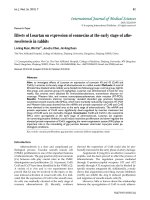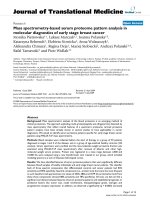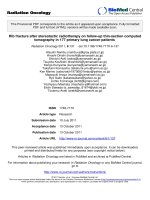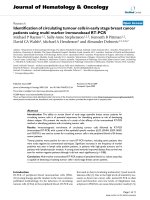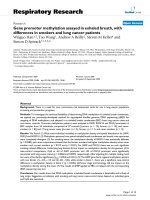risk of pleural recurrence in early stage lung cancer patients after percutaneous transthoracic needle biopsy a meta analysis
Bạn đang xem bản rút gọn của tài liệu. Xem và tải ngay bản đầy đủ của tài liệu tại đây (811.6 KB, 6 trang )
www.nature.com/scientificreports
OPEN
received: 19 August 2016
accepted: 13 January 2017
Published: 16 February 2017
Risk of Pleural Recurrence in Early
Stage Lung Cancer Patients after
Percutaneous Transthoracic Needle
Biopsy: A Meta-analysis
Ting Wang1,2, Lili Luo3 & Qinghua Zhou1
Percutaneous transthoracic needle biopsies (PTNB) are widely used for the diagnosis of a peripheral
pulmonary nodules, but the risk of pleural recurrence in lung cancer patients remains undetermined.
Our meta-analysis aims to answer the question whether PTNB strategy increases the risk of recurrence.
PubMed, EMBASE, The Cochrane Library, and China National Knowledge Infrastructure (CNKI) were
searched from inception to January 9, 2016. A total of 1242 patients from 5 studies were included. The
results showed that PTNB does not increase risk of total recurrence (Odds Ratio,0.78; 95% CI, 0.53 to
1.15) or pleural recurrence (Odds Ratio,1.58; 95% CI, 0.41 to 6.12) compared with non-PTNB strategies
in early stage lung cancer patients. Subgroup analysis showed that PTNB was associated with increased
pleural recurrence (Odds Ratio, 10.76; 95% CI, 2.92 to 39.70) in patients with sub-pleural lesions but
not in patients without sub-pleural lesions (Odds Ratio, 0.96; 95% CI, 0.24 to 3.89). In conclusion,
PTNB should not be recommended in lung cancer patients with sub-pleural lesions. However, PTNB is
recommendable to use in other patients without sub-pleural lesions to whom pathological diagnosis is
necessary, especially in patients with relevant comorbidities.
Percutaneous transthoracic needle biopsies (PTNB) are widely used for the histologic diagnosis of a peripheral indeterminate pulmonary nodule and reported a high diagnostic yield of 90% sensitivity and 97% specificity1,2. However, pleural recurrence was also reported as a long term complication of PTNB in many literatures3–6.
Recent evidence focusing on recurrent outcomes after PTNB was controversial7–11. In 2005, Matsuguma et al.
reported that PTNB could cause a higher pleural recurrence rate (9.1%) than bronchoscopy biopsy and sputum
(1%) in patients with resected stage I non-small cell lung cancer7. In 2011, Inoue M et al. also reported that PTNB
might increase the risk of pleural implantation in stage I lung cancer patients, especially patients with stage IB
disease8. However, the pleural recurrence of early stage patients with lung cancer reported in other studies were
not affected by PTNB9–11.
The evidence on this topic is controversial. Although several reviews of PTNB have been published, most of
them focused on the diagnostic yield and incidence of short term complications such as pneumothorax or hemorrhage1,12,13. We therefore conducted this meta-analysis to assess whether PTNB strategy will increase the risk
of pleural recurrence.
Methods
Eligibility criteria. This meta-analysis was performed according to the PRISMA (Preferred Reporting Items
for Systematic Reviews and Meta-Analyses) statement and MOOSE (Meta-analysis Of Observational Studies
in Epidemiology) guidelines14,15. Randomized clinical trials (RCTs) and cohort studies, being published from
1966 to November 9, 2016, which reported comparisons of recurrence or pleural recurrence between patients
diagnosed by PTNB or other invasive techniques, such as open surgery, video assisted thoracoscopic surgery or
bronchoscopy biopsy etc., were included. The study participants were patients with histologically or cytologically
1
Lung Cancer Center, West China Hospital, Sichuan University, Chengdu, Sichuan, China. 2Department of Medical
Oncology, Sichuan Cancer Hospital & Institute, Sichuan Cancer Center, School of Medicine, University of Electronic
Science and Technology of China, Chengdu, China. 3Department of Pediatrics, West China Second University
Hospital, Sichuan University, Chengdu, Sichuan, China. Correspondence and requests for materials should be
addressed to Q.Z. (email: )
Scientific Reports | 7:42762 | DOI: 10.1038/srep42762
1
www.nature.com/scientificreports/
Figure 1. Flowchart of the process for the identification of relevant studies.
confirmed stage I lung cancer. The main intervention was PTNB of all types, such as CT-guided PTNB or ultrasonography-guided PTNB. The studies focusing on transbronchial needle aspiration or intraoperative needle
biopsy would be excluded.
Search strategy. An electronic search in PubMed, EMBASE, The Cochrane Library, and China National
Knowledge Infrastructure (CNKI) were conducted from 1966 to November 9, 2016 by two investigators (Ting
Wang and Lili Luo). The following key words in combination as medical subject heading terms and text words
were used: “lung cancer”, “percutaneous transthoracic needle biopsy”, “pleural recurrence” OR “recurrence”.
Potentially relevant articles were identified by reading titles and abstracts. The full texts of the relevant articles
were read to determine whether they met the inclusion criteria. The references were also searched to identify
relevant studies. Only studies published in English were searched and included. For studies without outcome data
mentioned above, the corresponding author was contacted.
Quality assessment. For RCTs, methodological quality was assessed using the five point Jadad scale. For
cohort studies, the 9-star Newcastle-Ottawa Scale (NOS) was used to assess the risk of bias16,17. The NOS scale
is an 8-item instrument that allows for assessment of patient population and selection, study comparability,
follow-up, and outcome. Interpretation of the scale is performed by awarding points for high-quality elements.
Studies with 5 or more stars were defined as high-quality studies and were included. Quality assessment was
performed by two investigators independently (Ting Wang and Lili Luo). Any disagreement will be present to
discuss within all authors.
Statistical analyses. A unified form for data extraction was used. Study information including author name,
study year, sample size, tumor size and event number in each group were collected. The pooled odds ratio was
used to compare the recurrence rate or pleural recurrence rate between PTNB group and non-PTNB group. The
pooled OR and its 95% confidence interval (CI) were calculated using the Z test, along with 95% CIs. Statistical
heterogeneity between studies was examined using the Cochrane Q test by calculating the I2 value18. An I2 value
Scientific Reports | 7:42762 | DOI: 10.1038/srep42762
2
www.nature.com/scientificreports/
Sample size
Study
Matsuguma H
2005
Study type
Location
PTNB
NonPTNB
Cohort study
Japan
66
224
Period
Median
follow-up
(months)
1986–2000
80
Tumor size (cm)
Stage
PTN
B
Non-PTN
B
Type of
biopsy
I
2.38
2.90/3.95
CCNB
18 G
Therapy
Quality
scores
Surgery
7
Inoue M 2011
Cohort study
Japan
131
316
1992–2008
60.4
I
2.5
2.7
CCNB
Surgery
8
Asakura K 2012
Cohort study
Japan
124
197
2002–2009
45/42
I
1.9
2.5
CCNB
18 G
Surgery
8
Flechsig P 2015
Cohort study
Germany
26
9
2003–2010
17
I
NR
NR
CCNB
15 G
Surgery,
chemotherapy,
radiotherapy
6
Kashiwabara K
2016
Cohort study
Japan
63
86
2009–2014
43.2
I
2.1
2.7
FNB
21 G
Surgery
8
Table 1. Characteristics of included studies. *PTNB: percutaneous transthoracic needle biopsies; CCNB: CTguide transthoracic core needle biopsy, CNB: fine needle biopsy.
Figure 2. Forest plot showing the impact of PTNB on total recurrence. *CI: confidence interval, PTNB:
percutaneous transthoracic needle biopsy.
greater than 50% or p value less than 0.05 were considered to represent significant heterogeneity. For RCTs, the
pooled HR and the 95% confidence interval (CI) were calculated using the Mantel-Haenszel formula (fixed-effect
model) when heterogeneity was not detected (p > 0.05), or using the DerSimonian-Laird formula (random-effect
model) when heterogeneity was significant (p < 0.05)19. For cohort studies, the DerSimonian-Laird formula
(random-effect model) were used. Publication bias was evaluated using the funnel plot and the Begg’s test20.
Statistical analyses were performed using RevMan5.3 software (the Cochrane Collaboration, Oxford, England).
Results
Study selection. Electronic search identified 394 potentially relevant references. Additional 12 references
were further identified by checking the reference list. After excluding duplicate and irrelevant references through
reading the abstracts, 39 references were read in full and 34 references were excluded for lack of data either on
recurrence or pleural recurrence. Finally, five references fulfilled the inclusion criteria and provided data for the
meta-analysis7–11. Figure 1 shows the flowchart of the search results.
Characteristics of included Studies. According to the searching result, no RCTs fulfilled the inclusion
criteria. All five included articles were cohort studies published from 2005 to 20167–11. This study included 1242
patients and contained four studies from Asia (Japan)7–9,11 and one study from Europe (Germany)10. Potential
confounders, such as tumor stage, tumor size, age, gender, history of smoking, histological type and surgical
approach were reported and adjusted in some of included studies. The quality score of included studies ranged
from 6 to 8 stars. Characteristics of the included studies are listed in Table 1.
Impact of PTNB on total recurrence. Four studies reported the recurrence between PTNB and
non-PTNB groups 7–9,11. Significant heterogeneity was not found among studies (I 2 = 23%, p = 0.28).
Random-effect model was used to perform the meta-analysis of cohort studies. The pooled OR estimate was 0.78
(95% CI, 0.53 to 1.15; p = 0.21; Fig. 2), which means PTNB is not associated with recurrence in stage I lung cancer
patients.
Impact of PTNB on pleural recurrence. Five studies reported the pleural recurrence between PTNB and
non-PTNB groups7–11. Significant heterogeneity was found among studies (I2 = 72%, p = 0.006). Random-effect
model was used. The pooled OR estimate was 1.58 (95% CI, 0.41 to 6.12; p = 0.50; Fig. 3A), which means PTNB is
not associated with pleural recurrence in stage I lung cancer patients. Subgroup analysis according to the tumor
location was performed. In patients with sub-pleural lesions, the pooled OR estimate was 10.76 (95% CI, 2.92 to
39.70; p = 0.0004; Fig. 3B). In patients without sub-pleural lesions, the pooled OR estimate was 0.96 (95% CI, 0.24
Scientific Reports | 7:42762 | DOI: 10.1038/srep42762
3
www.nature.com/scientificreports/
Figure 3. Forest plot showing the impact of PTNB on pleural recurrence and forest plot of subgroup
analysis according to tumor location. *CI: confidence interval, PTNB: percutaneous transthoracic needle
biopsy.
to 3.89; p = 0.96; Fig. 3C). These results showed that, for early stage lung cancer, PTNB will increase the risk of
pleural recurrence in patients with sub-pleural lesions but not in those without sub-pleural lesions.
Publication bias. Visual inspection of the funnel plots did not show the asymmetry typically associated with
publication bias. Evidence of publication bias was also not seen with the Begg’s tests of total recurrence (p = 0.309,
Fig. 4A) and pleural recurrence (p = 0.462, Fig. 4B).
Discussion
For pulmonary nodules, histopathological diagnoses are often important before appropriate therapeutic strategies are performed. For the recent decade, PTNB has been developed one of the most common diagnostic tools
in the management of such nodules, especially peripheral lung cancers1,2. Despite high diagnostic accuracy and
low short term complications have been widely studied for years, it is necessary to understand the long term
comorbidities like pleural recurrence related to diagnostic procedure. Some typical cases with pleural recurrence
and needle tract implantation have been identified since 1965 when PTNB was firstly reported to be used4,5,21–23.
A cohort study, however, was lack until 2005 Matsuguma, et al. reported that PTNB increased pleural recurrence in patients with stage I lung cancer7. Following Matsuguma, et al., several studies focused on this topic
were reported8–11,24. Another study by Wisnivesky et al. reported that the overall survival of patients after PTNB
was similar with patients diagnosed with other strategies, which is consistent with our results. The results of
our analysis demonstrate that the total recurrence and pleural recurrence are not significantly different between
PTNB and non-PTNB group in patients with early stage lung cancer. To the best of our knowledge, this is the first
meta-analysis focusing on this topic.
It is noteworthy that, despite the pooled analysis showed no difference on total recurrence and pleural recurrence, most included studies reported that patients in non-PTNB group had larger tumors and higher proportion of central tumor location than patients in PTNB group, which may cover and obscure the negative effect of
PTNB on prognosis. It is possible that much earlier diseases with smaller tumor sizes might be included in the
PTNB group which would result in better outcomes and false negative results. In addition, some studies included
higher proportion of peripheral tumor location in PTNB group which might account for the higher incidence
of pleural recurrence. Therefore, we restricted participants into stage I patients and performed the subgroup
analysis according to tumor location. The result showed that PTNB would increase the risk of pleural recurrence
in patients with sub-pleural lesions. But this risk was not found if the tumor was not located near the pleural. In
PTNB groups, the pleural recurrence rate of patients with sub-pleural lesions (from 15% to 25%) was significantly
higher than that of patients (from 0% to 12%) without sub-pleural lesions (Fig. 3), while in non-PTNB groups,
Scientific Reports | 7:42762 | DOI: 10.1038/srep42762
4
www.nature.com/scientificreports/
Figure 4. Funnel plots showing the publication bias of total recurrence and pleural recurrence.
the pleural recurrence rate of patients with sub-pleural lesions (from 2% to 4%) was similar with that of patients
(from 2% to 9%) without sub-pleural lesions. No study included in our analysis reported available data to perform
subgroup analyses according to tumor sizes, pathological subtypes, and other confounding factors.
There are some other limitations of this study. Our results are based on retrospective studies with small sample size, in most of which some important confounders such as tumor size, type of the surgery, adjuvant therapy, other diagnostic modalities, pathological subtype or baseline characteristics of patients could not be well
adjusted. The evidence is low-level and a few studies were available to analysis, which is a major limitation. Also
the median follow-up period of included studies were different and may lead to confounding factors for the limited number of event such as pleural recurrence or other recurrence. Additionally, different puncture methods
could also affect the results of outcomes. In some studies, patients received needle puncture more than twice per
procedure which might have increased the rate of pleural dissemination or recurrence compared with patients
received only once. The present study included both fine needle and core needle biopsy methods, and the type of
needle they used might influence the incidence of pleural recurrence. Actually, some significant heterogeneity was
detected and most of it was unexplainable.
In conclusion, based on current evidences, PTNB is not associated with increased total recurrence and pleural
recurrence in early lung cancer patients. But PTNB will increase the risk of pleural recurrence and should not
be used in early patients with sub-pleural lesions. However, PTNB, as a minimally invasive procedure, is recommendable to use in other patients without sub-pleural lesions to whom pathological diagnosis is necessary,
especially in patients with relevant comorbidities. Large scale, prospective, and multicenter studies are needed.
References
1. DiBardino, D. M., Yarmus, L. B. & Semaan, R. W. Transthoracic needle biopsy of the lung. J Thorac Dis 7, S304–316 (2015).
2. Wu, C. C., Maher, M. M. & Shepard, J. A. Complications of CT-guided percutaneous needle biopsy of the chest: prevention and
management. AJR Am J Roentgenol 196, W678–682 (2011).
3. Kara, M., Alver, G., Sak, S. D. & Kavukcu, S. Implantation metastasis caused by fine needle aspiration biopsy following curative
resection of stage IB non-small cell lung cancer. Eur J Cardiothorac Surg 20, 868–870 (2001).
4. Redwood, N., Beggs, D. & Morgan, W. E. Dissemination of tumour cells from fine needle biopsy. Thorax 44, 826–827 (1989).
5. Seyfer, A. E., Walsh, D. S., Graeber, G. M., Nuno, I. N. & Eliasson, A. H. Chest wall implantation of lung cancer after thin-needle
aspiration biopsy. Ann Thorac Surg 48, 284–286 (1989).
6. Kim, J. H., Kim, Y. T., Lim, H. K., Kim, Y. H. & Sung, S. W. Management for chest wall implantation of non-small cell lung cancer
after fine-needle aspiration biopsy. Eur J Cardiothorac Surg 23, 828–832 (2003).
7. Matsuguma, H. et al. Risk of pleural recurrence after needle biopsy in patients with resected early stage lung cancer. Ann Thorac Surg
80, 2026–2031 (2005).
8. Inoue, M. et al. Risk of pleural recurrence after computed tomographic-guided percutaneous needle biopsy in stage I lung cancer
patients. Ann Thorac Surg 91, 1066–1071 (2011).
9. Asakura, K. et al. Incidence of pleural recurrence after computed tomography-guided needle biopsy in stage I lung cancer. PLoS One
7, e42043 (2012).
10. Flechsig, P. et al. Invasive lung cancer staging: influence of CT-guided core needle biopsy on onset of pleural carcinomatosis. Clin
Imaging 39, 56–61 (2015).
11. Kashiwabara, K., Semba, H., Fujii, S. & Tsumura, S. Preoperative Percutaneous Transthoracic Needle Biopsy Increased the Risk of Pleural
Recurrence in Pathological Stage I Lung Cancer Patients With Sub-pleural Pure Solid Nodules. Cancer Invest 34, 373–377 (2016).
Scientific Reports | 7:42762 | DOI: 10.1038/srep42762
5
www.nature.com/scientificreports/
12. Boskovic, T. et al. Pneumothorax after transthoracic needle biopsy of lung lesions under CT guidance. J Thorac Dis 6 Suppl 1,
S99–S107 (2014).
13. Patel, J. D. Overcoming perceived hurdles in lung cancer screening: the low risk of complications of image-guided transthoracic
needle biopsy. J Oncol Pract 11, e360–362 (2015).
14. Moher, D., Liberati, A., Tetzlaff, J., Altman, D. G. & Group, P. Preferred reporting items for systematic reviews and meta-analyses:
the PRISMA statement. PLoS Med 6, e1000097 (2009).
15. Stroup, D. F. et al. Meta-analysis of observational studies in epidemiology: a proposal for reporting. Meta-analysis Of Observational
Studies in Epidemiology (MOOSE) group. JAMA 283, 2008–2012, (2000).
16. The Newcastle-Ottawa scale (NOS) for assessing the quality of nonrandomised studies in meta-analyses. />clinical_epidemiology/oxford.asp.
17. Jadad, A. R. et al. Assessing the quality of reports of randomized clinical trials: is blinding necessary? Control Clin Trials 17, 1–12
(1996).
18. Higgins, J. P. & Thompson, S. G. Quantifying heterogeneity in a meta-analysis. Stat Med 21, 1539–1558, (2002).
19. DerSimonian, R. & Laird, N. Meta-analysis in clinical trials. Control Clin Trials 7, 177–188, (1986).
20. Begg, C. B. & Mazumdar, M. Operating characteristics of a rank correlation test for publication bias. Biometrics 50, 1088–1101,
(1994).
21. Yoshikawa, T. et al. Lung cancer implantation in the chest wall following percutaneous fine needle aspiration biopsy. Jpn J Clin Oncol
30, 450–452 (2000).
22. Voravud, N. et al. Implantation metastasis of carcinoma after percutaneous fine-needle aspiration biopsy. Chest 102, 313–315
(1992).
23. Berger, R. L., Dargan, E. L. & Huang, B. L. Dissemination of cancer cells by needle biopsy of the lung. J Thorac Cardiovasc Surg 63,
430–432 (1972).
24. Wisnivesky, J. P., Henschke, C. I. & Yankelevitz, D. F. Diagnostic percutaneous transthoracic needle biopsy does not affect survival
in stage I lung cancer. Am J Respir Crit Care Med 174, 684–688 (2006).
Author Contributions
T.W. and Q.H.Z. conceived the study. T.W. design the study. T.W. and L.L.L. searched the literature and collected
the data. T.W. and L.L.L. performed the analyses. T.W. and Q.H.Z. drafted the manuscript. All authors reviewed
the manuscript.
Additional Information
Competing financial interests: The authors declare no competing financial interests.
How to cite this article: Wang, T. et al. Risk of Pleural Recurrence in Early Stage Lung Cancer Patients after
Percutaneous Transthoracic Needle Biopsy: A Meta-analysis. Sci. Rep. 7, 42762; doi: 10.1038/srep42762 (2017).
Publisher's note: Springer Nature remains neutral with regard to jurisdictional claims in published maps and
institutional affiliations.
This work is licensed under a Creative Commons Attribution 4.0 International License. The images
or other third party material in this article are included in the article’s Creative Commons license,
unless indicated otherwise in the credit line; if the material is not included under the Creative Commons license,
users will need to obtain permission from the license holder to reproduce the material. To view a copy of this
license, visit />© The Author(s) 2017
Scientific Reports | 7:42762 | DOI: 10.1038/srep42762
6
